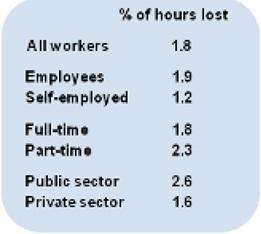What's behind higher rates of sick leave in the public sector?
"Public sector workers are 63 per cent more likely to take time off work sick than private sector employees, official figures revealed yesterday."
Daily Express 16 May 2012
Join 72,953 people who trust us to check the facts
Sign up to get weekly updates on politics, immigration, health and more.
Subscribe to weekly email newsletters from Full Fact for updates on politics, immigration, health and more. Our fact checks are free to read but not to produce, so you will also get occasional emails about fundraising and other ways you can help. You can unsubscribe at any time. For more information about how we use your data see our Privacy Policy.
"There is no reason for sickness rates to be so much higher for employees paid by taxpayers."
Taxpayers' Alliance spokesperson, quoted in The Sun.
Are public sector workers more sickly than their private sector colleagues? A number of newspapers this morning reported that those employed by the state took more than 60 per cent more days off work due to sickness than private sector workers.
The story is based upon a report released yesterday by the Office for National Statistics (ONS), titled 'Sickness absence in the Labour market — 2012'.
This found that in total "131 million working days were lost due to sickness absences in the UK in 2011". This is actually a fall of 26 per cent since 1993 (the period covered by the report), when 178 million working days were lost.

Much of the media attention focused primarily on the variation between the sickness rate recorded in the public and private sectors.
Public Sector Overall : 2.6% Private Sector Overall : 1.6%
The difference between the two absence rates is 62.5 per cent, acceptably rounded up to 63 per cent in the Express and down to 60 per cent in the Sun.

So is there really 'no reason' for the sickness rates to be higher in the public sector?
The report itself points to a number of possible explanations for the disparity between the public and private sectors.
For example, on average women have a higher rate of sickness than men (2.3 per cent and 1.5 per cent respectively) and as the ONS points out, women are better represented in the public sector than the private.
However a closer look at the figures shows that this can't account for all of the difference between the sectors, as it remains when gender is thrown into the mix:

However the ONS also points out the size and structure of the employees' organisation may also play a role in the varying sickness rates in the public and private sectors.
The report's measure of sick leave is calculated by deducting the number of hours worked from the total working hours stipulated in the employees contract. Those who took time off for sickness but made up the lost time at another point in the week would not be included.
The ONS notes that "it is possible that individuals in smaller workforces are under more pressure to make up any lost hours and these workforces are more prominent in the private sector."
This also highlights another factor that might also be at work: the size of the employer's organisation.
Larger workforces reported higher sickness levels, with organisation of over 500 employees recording the highest percentage of lost working hours in 2011 (2.3 per cent). In contrast, the smallest firms had the lowest absence rate of 1.5 per cent.
The report hypothesises that workers in small firms "do not feel able to take time off due to work commitments and not having colleagues to cover their work." Employees in the public sector are more likely to work for larger organisations than those in the private sector.

The different ways in which employees' contracts are structured is also highlighted as a possible reason for the public/private divide.
The report notes that "individuals within the private sector are also more likely to not be paid for a spell of sickness than individuals within the public sector." This may mean that private sector workers are more likely to work through a spell of sickness.
The distinction is particularly accute when we look at self-employed workers. Self-employed workers had a lower absence rate (1.2 per cent) than the members of the workforce classified as "employees" (1.9 per cent).

Conclusion
While the ONS explores some of the possible reasons for the difference in the number of sick days taken by public and private sector workers, it does not form the focus of its report, and so it doesn't attempt to quantify the impact of each.
However it does raise enough caveats to suggest that there is more to the story than simply public sector employees taking more 'sickies', the explanation offered in several newspaper headlines.